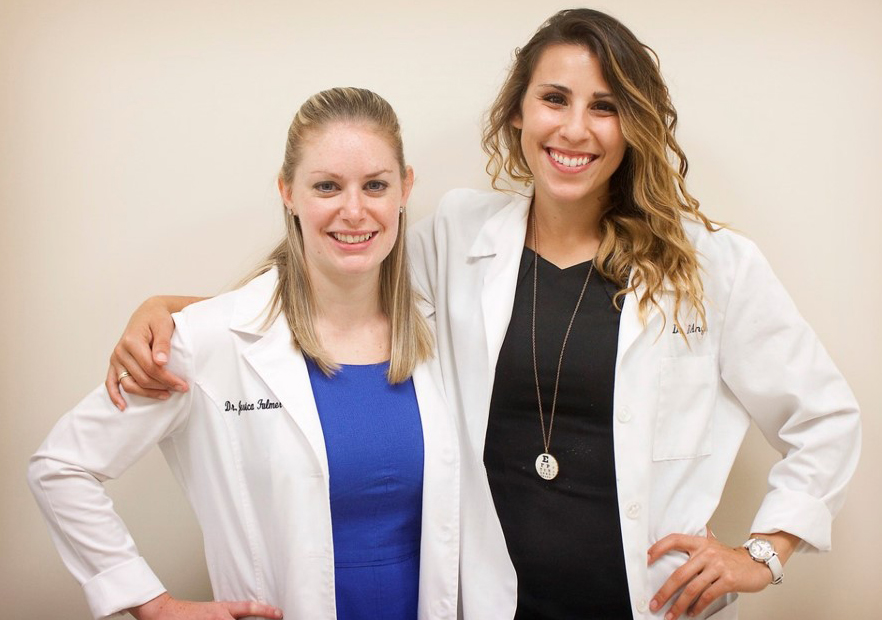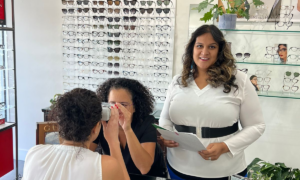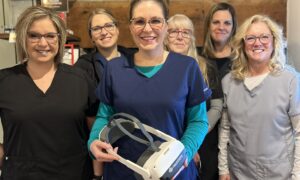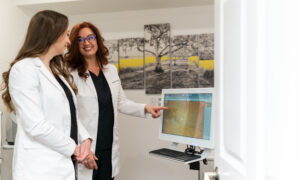
Dr. Licausi (far left as you look at photo) and Dr. Zilnicki (far right as you look at photo) with one of their traumatic brain injury patients. Drs. Licausi and Zilnicki says that they have learned to be informative, yet sensitive, when sharing potentially upsetting news with patients.
Bad news delivery strategies for optometrists.
By Miki Lyn Zilnicki, OD, FCOVD,
and Jessica Licausi, OD, FAAO, FCOVD
June 19, 2024
No one wants to hear bad news, least of all a patient who is at the doctor’s office.
However, as unwelcome as this information can be, there are ways to blunt the blow. Here is how we do it.
“Bad” News Means Something Different to Everyone
There is a large spectrum of “unhappy” news. We had people be absolutely devastated that their child needs glasses (which in the grand scheme of things is pretty minor!) all the way to a patient feeling relieved that the root cause of their symptoms is likely a pituitary gland tumor (a pretty major thing!).
Our practice is primarily a specialty care practice focusing on vision therapy and rehabilitation, so we deal with a unique subset of the population.
At one end of our patient spectrum are those with strabismus, amblyopia and/or binocular vision issues that can affect learning. At the other end of the spectrum is the traumatic brain injury population including post-concussion and post stroke patients, as well as the low vision population.
Unhappy news for the first half of our population comes in the form of telling parents that there is a visual issue preventing their child from fulfilling their academic potential, and that this issue is going to require time and effort to improve.
For the second half of our population, the recovery timeline can be a sensitive subject. Most of our post-concussion patients will recover and rebound, but there is a small cohort that will plateau in treatment and experience persistent symptoms that limit the activities they can safely resume. This results in a tough conversation about whether they can return to their previous job, and if not, whether they could consider receiving disability benefits or retiring.
2 Case Studies: Delivering the News
Dr Licausi: I see the bulk of our low vision patients in our practice. In this patient population driving can be a big topic of conversation. One of my dear patients with macular degeneration was referred to our practice by her retina specialist. When I began seeing her, her visual acuity still fell into a normal range that met our state requirements to pass for driving.
Other Articles to Explore
Over time, however, her macular degeneration progressed, and as her visual acuity declined, the tough topic of driving had to be addressed. My patient was anxious, especially when it came to her health, and had a limited support network. Her husband had passed away, her kids lived out of state and she lived alone. I knew I had to handle this conversation with grace and empathy.
As I discussed her decline in vision, I gently broached the subject of driving and that she no longer met our state’s visual requirements to drive. Her initial reaction was to spiral into how this would limit her independence moving forward.
We talked through that while her lifestyle would change, this was also a matter of safety for others on the road. Being an empathetic person, she instantly responded positively to this reasoning. This patient was able to employ the help of her neighbors, and her out-of-state daughter began visiting more to provide the transportation necessary for her.
Dr. Zilnicki (as told by Dr. Licausi): A recent “unhappy” encounter was a long-time patient who suffered a brain tumor in 2020 that resulted in an intermittent exotropia.
Through a course of vision therapy, this patient was able to remove the eye patch her neurologist gave her and regain single vision, return to work and was in a steady state of good vision with no tumor growth. At a routine follow-up in January with Dr. Zilnicki, this patient complained of a change in her visual acuity, and it had indeed dropped two lines, which prompted repeating her visual field testing. As this patient completed the testing, Dr. Zilnicki’s heart sank when there was notable field loss in the eye that the tumor had been on.
Dr. Zilnicki had to discuss with this patient that something indeed did change: either the tumor was growing back or this was a result of prior radiation treatment. This patient cried and asked many questions about if things would get worse, if her vision could be restored and what this meant for her professionally as she is a police officer.
Due to the uncertainty of the etiology, Dr. Zilnicki couldn’t offer her many answers to her questions, but assured her that we were going to act quickly and figure out what was going on. She made sure to keep an open line of communication with the patient and did a lot of hand holding as she underwent repeat neurology testing to reassess for tumor recurrence.
Patients Hearing Bad News May Not Believe You
In some cases, parents and patients react skeptically; they can be hesitant to believe what you are telling them. A young girl who was seven years old had a severe case of amblyopia: she was plano in one eye and a +8.00 in the fellow eye with her best corrected acuity in the 20/100 range.
The father could not understand why there were no “signs,” and that his daughter, despite our diagnosis, was thriving. We tried to explain the best treatment plan with contacts and vision therapy to improve visual acuity and eventually binocularity, but the dad felt like we were “selling” him something and never consistently followed through with treatment.
For any news that is received poorly, we both try to navigate the conversation in a way that keeps it professional by stating facts about the findings, the treatment plan and what this means for the patient. We are empathetic, but firm in our delivery and discuss that our ultimate goal is the patient’s safety and well-being.
Set Expectations Before Treatment So Bad News is Not a Surprise
Here are two examples of vision therapy patients who need to have their expectations set appropriately.
Our post-concussion patients are often concerned about getting back to their regular activities such as school, sports, work and/or driving.
Some patients with even the best interventions do not recover full function depending on the level of head injury. We are honest with patients that everyone recovers from a head injury differently and that their recovery is dependent not only on their success with vision therapy, but in conjunction with their other rehabilitative interventions.
We learned to not give definitive time frames for when activities can be resumed. Often for these patients, we recommend a trial of 12 sessions of vision therapy rather than determining the total length of their program. We found this gives us a good gauge of how they are responding to therapy along with how their symptoms and function is improving. At that first re-evaluation we can often better answer those questions of when and how they will re-integrate their normal activities.
With learning-related vision therapy cases it is important to address with parents that reading and academic performance are very multi-factorial. When visual dysfunctions are present, they are likely contributory to visual comfort and efficiency when reading and even comprehension/memory.
We always strive to present vision therapy as addressing part of the patient’s reading/academic puzzle rather than the whole picture. While improving binocular, accommodative, oculomotor or visual perceptual dysfunction can improve the patient’s reading, if other factors are present, reading may not improve to the level expected by the patient and their family.
Bottom Line: One Size Does Not Fit All
The key to delivering news: whether it be happy or unhappy, is to tailor your communication style to each individual patient and their needs.
Recommended Reading
We highly recommend “Treating People, not Patients” by Dr. Michael Sonick, DMD, and Scott Davis. Dr. Sonick discusses foundational ways to have high-quality communication with your patients.
“I Said This, You Heard That” by Kathleen Edelman is a wonderful resource for communication in general. Many of her concepts can be applied not only to your loved ones, but also to your patients. The book details how to assess the best communication style and technique to use based on each person’s unique mentality.
 Miki Lyn Zilnicki, OD, FCOVD, and Jessica
Miki Lyn Zilnicki, OD, FCOVD, and Jessica
Licausi, OD, FAAO, FCOVD, are co-owners of Twin Forks Optometry and Vision Therapy in Riverhead, N.Y.
To contact Dr. Zilnicki: DrZilnicki@twinforksoptometry.com.
To contact Dr. Licausi: DrLicausi@twinforksoptometry.com

























